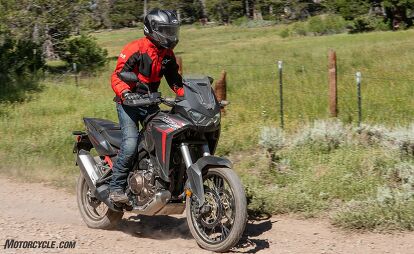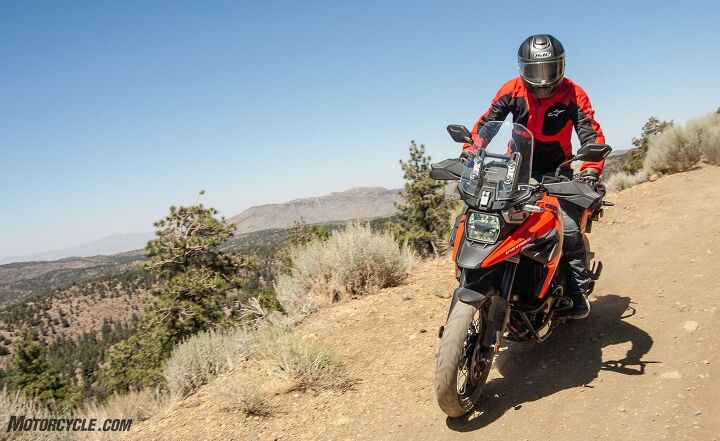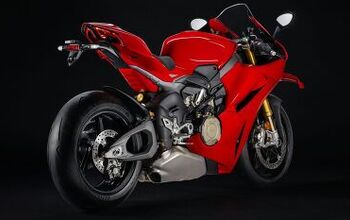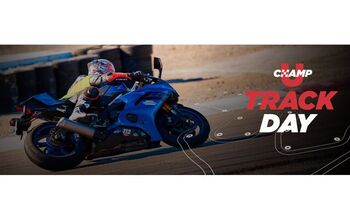2020 Honda CRF1100L Africa Twin Vs. Suzuki V-Strom 1050XT

Two spruced-up Japanese ADV bikes go head-to-head.
We’ll admit this is an unusual ADV test. There are any number of competitors we could have lined up against the new-and-improved 2020 Honda Africa Twin. Honda’s dirt-focused ADV bike has received a host of changes to make it even better both on-road and off, but it has always felt most at home when the paved path turns to the loose stuff.
However, the Suzuki V-Strom’s validity in this test shouldn’t be overlooked. A long-time favorite among the MO staff, we’ve always appreciated the ‘Strom’s performance, both on-road and off, even if it wasn’t the best in any particular category. Like the Honda, Suzuki has updated the V-Strom 1050 for 2020, and with both Japanese players getting refreshes, what better time than now to put them head-to-head?
In Honda’s case, the Africa Twin’s makeover centers on its larger engine – 1084cc, to be exact – achieved through a longer stroke. Cradling the bigger engine is a revised frame with several little changes, including a narrower, bolt-on subframe, that make one significant difference. What’s less obvious to see is the hugely updated electronics package centered around a Bosch IMU, giving the Africa Twin the latest traction control, wheelie control, and ABS capabilities, among a host of other changes.
If you’re curious to know more about the changes to both the standard Africa Twin seen here and the Adventure Sports version, we take an in-depth look at both bikes here. You can also read about my Quick First Ride of the standard AT, too.
On the Suzuki’s side, the V-Strom 1050XT gets a more dramatic aesthetic makeover, taking design cues from the DR Big off-roaders to look more, well, off-roady. The 1037cc V-Twin that can trace its roots back to the 1997 TL1000 sees some different camshafts for better peak power. Better still, a change to ride-by-wire means the V-Strom finally has cruise control.
Bringing the V-Strom into the modern age, it now comes with an IMU, too, reading yaw, pitch, and roll. Unlike the Honda, though, the ‘Strom uses the IMU mainly for cornering ABS and traction control functions. No wheelie control here. Also, ABS can only be disengaged by pulling the fuse under the seat. Not ideal. For a more thorough explanation of all the changes Suzuki made to the V-Strom, John Burns can tell you all about it in his First Ride review.
Taking Trizzle Out Of His Comfort Zone
Comparing these two motorcycles means getting a taste of each bike both on the road and in the dirt. Easy enough, since our ADV guy Ryan lives for this kind of stuff. But that also means we’d need a second rider – and that’s where Yours Truly comes in.
The thing is, though, my skills in the dirt are approximately the inverse of my skills on the road. I generally prefer having the Earth NOT move underneath me while I’m riding, not least of which because I usually end up hurting myself when I give dirtbikes a try. But since I’ve dragged Ryan – our resident off-road guy – along to plenty of racetrack tests throughout his time as a MOron, it’s only right the tables are turned around on me.
So, we bring you this comparison between the Africa Twin and V-Strom 1050XT from two very different perspectives: the off-road ace and the (terrified) noob. Since these bikes are street-legal, we did a fair bit of road riding, but also gave them a fair bit of time off the beaten path, too. As you’re about to see, the differences between them became apparent almost immediately.
Not Identical Twins
What we have with these two bikes is a tale of two engines. Both are Twins displacing over 1000cc, but that’s where the similarities end. The Suzuki, of course, splays its cylinders in a Vee while the Honda’s pistons reside right next to each other. Honda claims 101 hp at 7500 rpm (at least in Euro trim) with a torque output of 77 lb-ft. Suzuki, meanwhile, claims 106 hp at 8500 rpm and 73.8 lb-ft. At 6,000 rpm. Judging by our butt dynos, we’d say these claims are fairly accurate.
Looking past the numbers, however, we get into how the engines make power. There are a number of changes to the V-Strom engine, including a change in camshaft profiles for both the intake and exhaust. The result is slightly more top-end power compared to its predecessor, at the expense of bottom-end grunt.
By comparison, Honda engineers reached the new 1084cc displacement through a longer stroke compared to the previous model. Typically, longer strokes lead to lower rev ceilings, which means power is delivered earlier in the rev range. And that’s exactly the case here.
“Upping the [Suzuki] horsepower figure is great, but at the detriment of torque for a street/adventure bike doesn’t make sense to me,” Ryan notes. “To make matters worse, the bike has lost much of its low-end grunt that previously made the V-Twin so appealing.”
At the other end of the spectrum is the Africa Twin. Its engine pulls cleanly from as low as 2,000 rpm, with linear, accessible grunt that doesn’t feel like you’re straining it to get moving. Its transmission clicks from gear to gear as slick as you like, the ‘Strom feeling a little more mechanical in comparison.
If the manufacturer’s claimed power figures are anything to go by, then we’re dealing with two engines that, despite their marginal size difference, basically make the same amounts of power. But from where the rider is sitting, both Ryan and I agree the Honda feels like the more powerful and responsive of the two. This feeling likely has something to do with the extra 49 pounds the Suzuki carries around. On our electronic scales, the Honda weighed in at 495 pounds, the Suzuki at 544 pounds.
On-Road Manners
Despite its revamped adventure style, Suzuki says the new V-Strom 1050 XT is biased towards street riding. The first sign of this is its street-biased (tubeless) tires, but a closer look will discover the Suzuki’s 19-inch/17-inch wheel combo is smaller than the Honda’s 21-/18-inch setup, giving it better street manners.
Here’s Ryan: “Both bikes work well on the road and would be a pleasure to tour with. [Side note: neither bike comes with luggage, but the aftermarket is full of them.] In the twisty sections of said tour though, the V-Strom steers quicker, whereas the Africa Twin takes its time bending through corners due to the difference in wheel size.”
“Jumping from bike to bike, the wide-open cockpit of the Africa Twin is immediately noticeable. The V-Strom has a much narrower handlebar that’s also a fair bit lower. Thankfully, on the freeway, the AT’s dash and small windscreen do a pretty good job of not turning its rider into a sail at speed. The overall nod for wind protection between these two goes to the Suzuki though, thanks to its much taller windscreen.”
What Ryan is forgetting to mention is the V-Strom’s adjustable windscreen, which lends to the greater wind protection. However, Suzuki gets a demerit point for placing the latch to adjust the screen right above the headlight, forcing the rider to stop and get off the bike if they want to move the screen up or down.
Even though Ryan and I both measure at 5-feet, 8-inches, I didn’t have much of an issue with the Honda’s ergonomics on the road. The short, stationary windscreen pushed the air away from my chest and over my head, where it then created some turbulence and buffeting.
Over extended distances, I found myself extending my arms on the Suzuki a little more than I’d like to reach the bars. On the Honda, the seat-to-bar distance felt a tiny bit closer, allowing me to keep more of a bend in my elbows. But while I was more concerned with upper body comfort, Ryan took issue with the seat positions on both bikes. “In the lowest position they both gave me a less than comfortable bend at the knees over time while seated. Despite my 30-inch inseam, I would rather keep both seats in the higher position, even if it meant the ground would be further away.” I didn’t have as much discomfort with the hip/knee placement, but I do agree with Ryan about the higher seat position being more comfortable. Thankfully it’s easy to move the seats on both bikes in either the high or low position.
Personally, I found the Honda’s cockpit a more pleasant place to be. The reach to the bars is shorter, the seat is marginally more comfortable, and the bright, colorful, and clear TFT display is easy on the eyes. It truly is an impressive thing to look at, even in broad daylight. To its credit, the Suzuki’s LCD gauges give all the necessary information and would have been considered very attractive and cutting edge – ten years ago.
In its current trim, the ‘Strom’s 1037cc V-Twin gargles and struggles underneath 4,000 rpm, though it sings quite nicely above that mark. Like other Suzukis, the ‘Strom’s Idle Speed Control will pick up the revs a touch if you gently release the clutch from a stop without any throttle, helping to avoid stalling the bike.
Once moving on the road, you’re shifting the Suzuki like a bike with much less displacement to keep it in the sweet spot of its powerband. It’s a strange sensation to be shifting the ‘Strom so much, but it really doesn’t like to be below four-grand. Then, once you’re in the powerband, the Suzuki moves with intent – but I’d hesitate to call it urgency. There’s plenty of power on tap to evade cars, of course, but if you’re already at cruising speed and plan to make a pass on the highway, you’ll have to prepare for a downshift (or two) and a healthy whack of the throttle.
To be fair, the Honda doesn’t move with much urgency when you’re high in the revs either, but it wins out with its bottom-end grunt and smooth, linear powerband.
The ride quality on either bike is comfortable on the road, but the Suzuki’s slightly firmer suspension is evident on the road, as the ‘Strom is clearly the more sporty of the two.
Combine the suspension travel with the smaller wheels and street tires, and the Suzuki understandably excels when the road gets twisty. It’s quicker to turn, but the narrow handlebar makes you wonder if you could attack the corners even more aggressively if it was wider. Then again, if you’re looking to attack the corners much more aggressively, the V-Strom is probably the wrong bike for you, anyway. Wider bars would be a welcome addition anyway once you leave the tarmac, but we’ll get to that in a moment.
For its part, the Africa Twin makes no secret it prefers to be off road than on. It’s noticeably slower to turn than the ‘Strom, due in part to the larger wheels and tires, but also partially because of its longer wheelbase. However, its wider bar gives significantly more leverage so you can muscle it around and keep chase with your buddy on the ‘Strom.
The beauty of both bikes is how seamlessly the electronics operate and intervene – if they even do. It’s hard to tell. The Africa Twin integrates the latest Bosch MM7.10 IMU and all the advantages it brings to the table, like cornering ABS, traction control, engine brake and wheelie control. Apart from the latter, if we did trigger the interventions to kick in on the road, we honestly couldn’t tell. The system is that advanced. The level of adjustment, all available from the left switchgear or the touchscreen, is equally as impressive.
Suzuki didn’t skimp out with the V-Strom either, adding an IMU as well. Its operation is also hard to tell on the street, though you only get ABS and traction control. Both bikes allow you to adjust the TC levels, but the Honda has seven settings (eight, including off) while the Suzuki has three (four, including off).
While the Suzuki may be the more road-oriented bike between the two, Ryan and I thoroughly enjoyed the Honda on the pavement. It doesn’t give up much, if anything to the Suzuki. Sure, it handles a little slower, but you can still muscle it around if you please. What it boils down to is the Honda’s refinement, along with the joy we get from opening the throttle and letting the 1084cc Twin sing.
No matter which engine you choose, we saw fuel mileage numbers that were nearly identical: 42.3 mpg for the Honda, 42.6 mpg for the Suzuki. Both have at least five-gallon tanks (5.3 gallons on the V-Strom), so you can go pretty far before a refill.
Off-Road Manners
Well, this is a little awkward. The Honda gets our street nod despite the fact that the Suzuki was meant for the roads. What happens now, when we take the bikes to the Honda’s territory? As you can probably imagine, the gap between the two grows considerably. I’ll let Ryan explain why.
The 2020 Africa Twin’s chassis upgrades from the suspension to the frame itself seem to keep an already stable machine even moreso. Riding the bike fast down rocky Jeep roads is a real treat. Most bikes with some ground clearance and travel can meander their way through obstacles off-road with good line selection. What sets a capable adventure bike apart is how well it can handle those obstacles when the pace picks up. A 495-pound bike with a 1084cc parallel-Twin needs to be well-sorted in the chassis department to be usable in adverse conditions, and the Africa Twin is just that.
Riding the Suzuki V-Strom 1050 XT off-road is an entirely different experience. Sure, it doesn’t have dedicated off-road modes dialing in TC levels, engine braking, or throttle response, but it does allow for a few levels of TC (including the ability to turn it off). It also has a selection of power modes. The biggest disappointment with the Suzuki’s off-road electronics is the inability to disable ABS without pulling a fuse.
The street-oriented Suzuki does fine off-road. It’s fairly easy to manage as long as the speeds are kept in check. When you start pushing the pace on the V-Strom, you feel like you’re inevitably going to break something.
Two major factors of the Africa Twin’s off-road performance can be attributed to the wheel sizes and suspension. The AT’s Showa suspension gives the bike over nine inches of travel at each end and nearly 10 inches of ground clearance. In addition, its stock settings provide ample damping for rocky terrain while staying compliant in sandier sections. Once the pace ramps up, or if you find yourself riding one type of terra more than the other, you’ll likely want to start making adjustments, of which the AT offers compression, rebound, and preload both fore and aft. The Africa Twin’s 21/18-inch wheel combo not only helps with off-road maneuverability, but also gives riders access to a large swath of tires ranging from road going meats to full knobbies.
The tall wide bar on the Honda lends a dirtbike-esque position while standing and the short windscreen stays out of the way for when the riding gets more aggressive. On the Suzuki, the shorter, narrower handlebar puts the rider in a slightly awkward position and also forces the rider closer to catching the top of its windscreen to the helmet, or worse, the throat.
While Ryan clearly favored the Africa Twin off-road, the beauty of the Honda is how much easier it is to ride off-road for someone of my lame talents. Many of the attributes Ryan favored off-road, also made the dirt portion less terrifying for me, too. Considering the massive difference in speed the two of us have off-road, I noticed two main benefits: the tires and the chassis.
Having the larger wheel/tire combo, I could tell the AT rolled over obstacles noticeably better. In contrast, the Suzuki had a harder time with obstacles. Its decreased suspension travel didn’t do it any favors, either. Adding dirt to the ‘Strom’s wound (pun intended), the street-biased tires didn’t do it any favors in the sandy stuff, either, as the front pushed easily.
We’ve already mentioned the Suzuki’s ABS, and the need to pull a fuse to turn it off. The Honda’s Off-Road riding mode gives you the softest power application but also activates Off-Road ABS. We thought this meant rear ABS deactivation – it doesn’t. Instead, there’s an off-road ABS algorithm. While it’s highly sophisticated, both Ryan and I (though more so Ryan) preferred turning ABS off entirely. Something you can easily do with a few button pushes.
Winner
If you’ve read this far, the winner should be fairly obvious. By all our metrics the Suzuki V-Strom was satisfactory at best, which, in a way, continues the reputation the ‘Strom has long had as a motorcycle that doesn’t necessarily do anything wrong.
In this case, though, the Honda simply does everything better. Here’s Ryan:
The 2020 Africa Twin is a serious contender for adventurers shopping the 1,000cc-plus adventure market. The new AT is packed with the latest tech, a significant engine upgrade, and chassis updates that give the base model even better off-road performance than the previous year. Suzuki’s V-Strom 1050 XT received a complete facelift for 2020, but under that new retro DR Big styling we have a slightly revised 23-year old engine, with electronics that are just starting to catch up to what is deemed as acceptable these days. Combine that with an MSRP $400 higher than the base Africa Twin, and you’ll understand my skepticism.
Ah, yes. Price. The final nail in the Suzuki’s coffin is its MSRP. As tested, the V-Strom 1050 XT will set you back $14,799. The Honda? $14,399. To be fair, the base V-Strom can be had for $13,399, but you give up a center stand, crash bars, and cruise control in the process. You also get cast wheels – practically a non-starter if doing anything off-road is in the cards.
Here’s Ryan again:
Troy already said it in his Africa Twin review, but that motor. Dang. The difference between the previous mill and this new stroked parallel Twin is night and day. The Honda delivers significant punch under 2,000 rpm and keeps the party going well into its mid-range. The power is tractable and easy to manage both off-road and on. If you don’t want to be the one responsible for reining yourself in, there are plenty of electronics to tweak to keep yourself from getting out of control. Honda also delivers this increased performance while managing to shave 5.5 lbs off of the motor.
In terms of rider aids, these two couldn’t be further apart. The Honda introduces a mind-boggling amount of electronic adjustment while the ‘Zuki skates by with the bare minimum by today’s standards. Still, both can be appealing to different riders.
Sure they can. But to the two riders involved with this test, the choice was clear. Honda’s Africa Twin all the way.
Troy’s Gear

Helmet: HJC RPHA 90 Tanisk $450-$455
- Jacket: Alpinestars Tailwind Air Waterproof Jacket Tech-Air Compatible $400
- Airbag: Alpinestars Tech-Air Street Vest $800
- Pants: Alpinestars Crank Riding Jeans Discontinued
- Gloves: Alpinestars SP-2 v2 Gloves $140
Boots: Alpinestars Faster 3 Rideknit Shoes $180
Ryan’s Gear

Helmet: Klim Krios Valiance Helmet $500
- Jacket: Klim Baja S4 Jacket $550
- Pants: Klim Baja S4 Pants $550
- Gloves: REV’IT! Sand 3 Gloves $120
- Boots: SIDI Adventure 2 Gore-Tex Boots $450
Pack: Kriega R15 Backpack $139
2020 Honda Africa Twin
+ Highs
- Killer engine
- Impressive electronics
- Just gets better off-road the faster you go
– Sighs
- Steers a little slow on-road
- Engine protection is a must – it’s awfully vulnerable
- Navigating the electronics is pretty daunting
2020 Suzuki V-Strom 1050XT
+ Highs
- Fresh redesign
- Nice street manners
- Cruise control!
– Sighs
- Engine’s gutless below 4,000 rpm
- Not nearly as capable off-road as the Honda
- Why can’t I push a button to turn off ABS?
Specifications | Honda CRF1100L Africa Twin | Suzuki V-Storm 1050XT |
|---|---|---|
| MSRP | $14,399 | $13,999 base $14,799 (as tested, with cruise control, center stand, handguards, tool-less adjustable windscreen) |
| Engine Type | 1084cc liquid-cooled, four-stroke 22.5˚ parallel-twin | 1037cc liquid-cooled, four-stroke 90˚ V-Twin |
| Bore and Stroke | 92.0 mm x 81.5 mm | 100.0 mm x 66.0 mm |
| Fuel System | PGM-FI electronic fuel injection (Throttle By Wire) | Fuel injection, Ride-by-Wire |
| Compression Ratio | 10.1:1 | 11.5:1 |
| Valve Train | Unicam, 4 valves per cylinder | 4 valves per cylinder, DOHC |
| Transmission | 6-speed Manual | 6-speed constant mesh |
| Final Drive | #525 Chain; 16T/42T | Chain, O-ring type, RK525SMOZ8, 116 links |
| Front Suspension | 45mm inverted telescopic fork; 9.1 inches of travel | 43mm KYB Inverted telescopic, coil spring, oil damped, fully adjustable(?) |
| Rear Suspension | Pro-Link system w/ single shock; 8.7 inches of travel | Link type, single shock, coil spring, oil damped, preload and rebound adjustable |
| Front Brake | Two four-piston hydraulic calipers w/ 310mm disks; ABS | Tokico, 4-piston calipers, 310mm discs, ABS |
| Rear Brake | Single one-piston hydraulic caliper w/ 256mm disk; ABS | Nissin, 2-piston, single disc, ABS |
| Front Tire | 90/90-21 | 110/80R19 M/C (59V), tubeless |
| Rear Tire | 150/70R-18 | 150/70R17 M/C (69V), tubeless |
| Rake/Trail | 27.5° / 4.4 inches | 25.5° / 4.3 inches |
| Wheelbase | 62 inches | 61.2 inches |
| Seat Height | Standard position 34.3 inches/Low position 33.5 inches | Standard position 33.5 inches/High position 34.3 inches |
| Curb Weight | 495 pounds (measured) | 544 pounds (measured) |
| Fuel Capacity | 5 gallons including 1.0-gallon reserve | 5.3 gallons |
| Ground Clearance | 9.8 inches | 6.3 inches |
| Available Colors | Matte Black Metallic | Pearl Brilliant White/Glass Blaze Orange, Champion Yellow No. 2 |

Troy's been riding motorcycles and writing about them since 2006, getting his start at Rider Magazine. From there, he moved to Sport Rider Magazine before finally landing at Motorcycle.com in 2011. A lifelong gearhead who didn't fully immerse himself in motorcycles until his teenage years, Troy's interests have always been in technology, performance, and going fast. Naturally, racing was the perfect avenue to combine all three. Troy has been racing nearly as long as he's been riding and has competed at the AMA national level. He's also won multiple club races throughout the country, culminating in a Utah Sport Bike Association championship in 2011. He has been invited as a guest instructor for the Yamaha Champions Riding School, and when he's not out riding, he's either wrenching on bikes or watching MotoGP.
More by Troy Siahaan



































































































Comments
Join the conversation
It should be noted that this Africa Twin also has cruise control. This article mentions it many times for the V-Strom (and kudos to Suzuki!), but if you didn't know better, you'd think it was omitted on this base Honda AT. I'm still pissed that my VFR1200X didn't have CC, so I have to credit Honda when they deserve it. Maybe Honda will stop omitting CC on the other models that deserve it, like the CB1000R. I mean WTF, it's throttle by wire! Ridiculous
The Suzuki has a front porch. Who's idea was that?